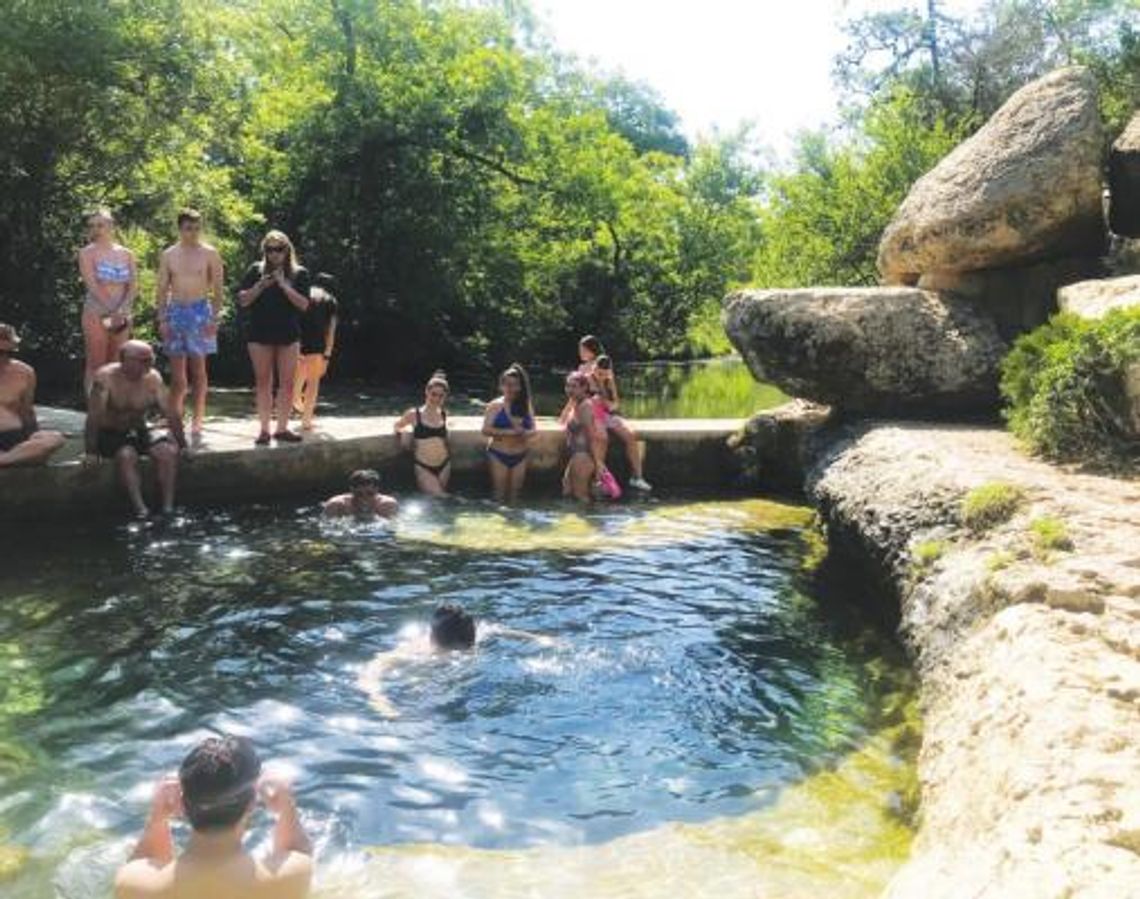With the heat of the summer upon us, one of Wimberley’s iconic swimming holes has closed for swimming as of June 29. This might be a glimpse of what the future holds for Jacob’s Well if Wimberley isn’t able to come to terms with its reliance on groundwater and the droughts of the future, according to those who have been trying to protect the well for decades.
“Swimming at Jacobs Well will be closed until the flow picks up and we see it is safe for swimming,” Jay Taylor, Lead Parks Specialist for the Hays County Parks Department, said in a statement. “We haven’t received substantial rainfall over our recharge zone in over a year, causing the flow rate of Jacobs Well to drop to almost nothing. This is causing poor water quality and the spring has become stagnant. The preserve is still open for hiking and viewing the spring but we cannot open swimming until the flow picks up and we see it is safe to enter the water again. We would like everyone to understand that water conservation during times of drought is highly important for our groundwater supply.”
Jacob’s Well is the headwaters of Cypress Creek. At points in the last two weeks, the flow of Jacob’s Well has dropped as low as onetenth of a cubic foot per second, which is all but zero flow. Even with last week’s rains, the flow barely climbed above one cubic foot per second. According to Robin Gary, managing director for the Wimberley Valley Watershed Association, eight cubic feet per second is a “healthy stream habitat with lots of dissolved oxygen.” Four cubic feet per second is considered healthy for fish. She said that what is occurring right now is not a healthy aquatic habitat.
“In the Hill Country, springs and rivers show what is happening to groundwater supplies,” Gary said. “Not being able to swim at Jacob’s Well because flow is too low may be the most visible drought impact, but groundwater storage in the Middle Trinity Aquifer is nearing record lows, too. With this prolonged dry period, rain hasn’t generated much recharge for our aquifers; we see this in groundwater levels, spring and river flows. Jacob’s Well and the Trinity Aquifer that most residents rely on for potable water are influenced by drought, but also by groundwater use. During summer months, water use spikes for outdoor watering and we visibly see the impact of that increased pumpage in the spring flow record. Until we get meaningful recharge, water conservation will be key to extending our existing water supplies.”
The water that comes out of Jacob’s Well is still pure spring water. Recent testing has actually shown very low levels of E. coli in the well. E. coli is a bacteria that is considered an indicator of a dangerous swimming habitat when found in large amounts. The state of Texas suggests that when E. coli levels reach a certain point, swimming is not safe.
“We have the pristine rivers and creeks here because of groundwater flow,” David Baker, executive director of the Wimberley Valley Watershed Association, said. “The issue is if we over pump the aquifer. If there is no quantity of water there is no quality. That is the key. We’ve got to keep the base flow in these systems for the aquatic life to stay healthy and for the contact recreation standards to be met. Keep Cypress Creek clean, clear and flowing. That is what drew most of us here in the first place. I think everybody wants to keep it that way, but this is a wake up call. The well is the canary in the coal mine for the aquifer. It is time for us to pay attention. Nobody wants to lose something as big of a treasure as Jacob’s Well.” But even with clean water coming out of the aquifer, with the flow as low as it is and swimmers allowed in to rotate every two hours throughout the day, other problems begin to emerge.
“Naturally, Jacob’s Well is very low E. coli, but with such low flow it doesn’t have the ability to clear out after such heavy use and flush out everything that comes with 60 people swimming every two hours,” Gary said. “Because spring flow is so low, the system can’t flush itself out. I think (the county is) wise to recognize there is a flow constraint to the recreational use of Jacob’s Well.”
The aquifers below are the entire water supply for everyone in the Wimberley Valley. There are no other sources of water. According to those who study Jacob’s Well, the low flow is caused by two factors – drought and over pumping the aquifer.
“It is really the drought and the over pumping of the aquifer that is the problem here, because we don’t have any flow,” Baker said. “…That is the big concern – over pumping the aquifer and not having any significant rain that has recharged the aquifer this spring.”
Baker said that the impacts of pumping can be seen in the USGS gauge that tracks spring flow every few minutes at Jacob’s Well and has for years. He said that the daily increase and decrease of spring flow, which is reported every week on the front page of the Wimberley View, is associated with two Aqua Texas wells in Woodcreek North.
“I don’t know that everybody in Woodcreek North understands that when they turn their tap on, that is water that would have come out of Jacob’s Well and into Cypress Creek,” Baker said. “The water we use in our daily life is the same water flowing down Cypress Creek.”
Jacob’s Well stopped flowing for the first time in modern history in 2000 and has come to a stop a handful of times since.
“I think if we continue on with the status quo pumping out of that area we will see longer dryer periods,” he continued. “I think with the climate, we will see longer droughts, and I think we would see longer periods of no flow of Cypress Creek. There could become a point where Cypress Creek only flows during wet periods. It is not only a natural wonder. It is the backbone of our whole economy. The flow of that spring and creek draw hundreds of thousands of visitors that stay in our bed and breakfasts and shop in our shops and eat in our restaurants. There is a lot that is connected to that flow. The good news is there are solutions.”
Some of those solutions have already been put into action. The federally funded Cypress Creek Watershed Protection Plan, managed by the Meadow’s Center for Water and the Environment at Texas State University, was approved in 2014 and has started many initiatives in the valley to try and preserve the water quality and stream flow in Cypress Creek. One such example is Wimberley ISD’s “One Water” school Blue Hole Primary, which was the first school in the state of Texas to use the One Water concept. The design of the school decreases the use of water and increases the re-use of wastewater through multiple measures. The Wimberley Village Library is working to design their expansion on similar grounds.
The Hays Trinity Groundwater Conservation District has also created the Jacob’s Well Groundwater Management Zone. The new zone allows the district to limit new permits within its boundaries as well as use more strict water conservation measures in an effort to keep flow at least above two cfs at Jacob’s Well, if not higher.
But there are still other ideas that could help.
One idea Baker has pursued is having some of the public water supply wells located in the Jacob’s Well GMZ relocated to areas further downstream in the aquifer and pumped back up to residents above Jacob’s Well. He said that may be enough to restore half to one full cubic foot per second of flow to Jacob’s Well, which may be enough to keep it flowing through such prolonged droughts. Land conservation in the area is important, and Baker is also concerned with the continued development of Woodcreek North.
“Every new house up there has a little less water that is going to come out of Jacob’s Well,” Baker said. “That is something we have to look at as a community and come up with a plan on how to mitigate that or we will see longer periods where there is no flow in Cypress Creek.”
Beyond projects, plans and praying for rain, there are things that can be done immediately to help.
“Everyone needs to conserve water,” Baker said. “Eliminate outdoor watering and limit water use as much as possible… Adopt rainwater harvesting and xeriscaping and everything we can do to reduce our own water footprint.”
For more information on how to save water locally, visit wimberleywatershed.org.
Wimberley’s history, beauty and lore are intertwined with the cold, deep waters that spring forth from the aquifer below and bless this region with Cypress Creek. This is the third in a multi-part series looking at the historical, cultural and environmental impacts created by diving into Jacob’s Well.







